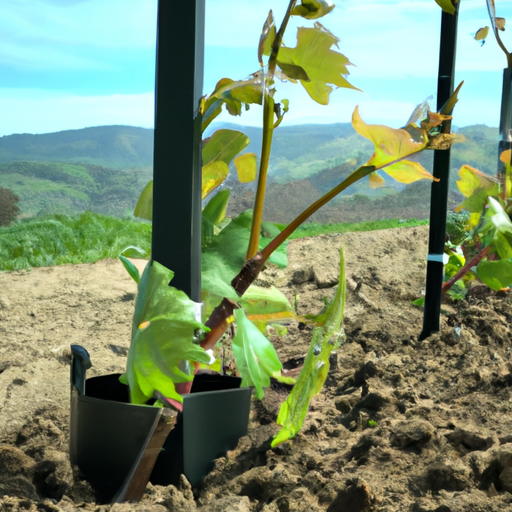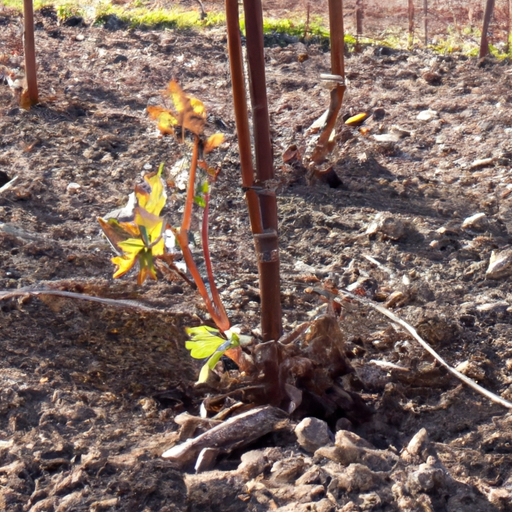
The Importance of Replanting in Maintaining Vineyard Health
Replanting at Jordan Estate Vineyard: A Second Chance for Growth
Vineyards are not just picturesque landscapes; they are living ecosystems that require careful attention and maintenance. One crucial aspect of vineyard management is replanting, which involves removing old vines and replacing them with new ones. Replanting is essential for maintaining vineyard health and ensuring the production of high-quality grapes.
Over time, vines age and become less productive. They may also succumb to diseases or pests that can spread throughout the vineyard if left unchecked. Replanting allows vineyard owners to address these issues and give their vineyard a fresh start. By removing old vines and replacing them with healthy, disease-resistant varieties, vineyard managers can ensure the long-term viability of their operation.
Replanting is not a decision that vineyard owners take lightly. It requires careful planning and consideration. Before replanting, vineyard managers must assess the health of the existing vines and determine if replanting is necessary. They also need to consider factors such as soil quality, climate, and grape variety selection. These decisions can have a significant impact on the success of the replanting process.
One of the primary reasons for replanting is to combat diseases that can devastate a vineyard. Grapevines are susceptible to a range of diseases, including powdery mildew, downy mildew, and grapevine leafroll virus. These diseases can weaken the vines, reduce grape yields, and affect the quality of the grapes. Replanting with disease-resistant varieties can help prevent the spread of these diseases and ensure the long-term health of the vineyard.
Another reason for replanting is to improve grape quality. As vines age, their ability to produce high-quality grapes diminishes. The grapes may become smaller, less flavorful, or more prone to disease. Replanting allows vineyard owners to select grape varieties that are better suited to their specific climate and soil conditions. This can result in grapes with more intense flavors, better structure, and improved aging potential.
Replanting also provides an opportunity for vineyard owners to experiment with new grape varieties. As consumer tastes evolve, vineyard managers may want to explore different grape varieties that are in demand. Replanting allows them to introduce these new varieties and adapt to changing market trends. It also gives them the chance to innovate and create unique wines that stand out in a crowded marketplace.
The process of replanting is not without its challenges. It requires careful vineyard management to ensure the successful establishment of new vines. Soil preparation, irrigation, and pest control are all critical factors that need to be considered. Additionally, replanting can be a costly endeavor, requiring significant investment in new vines, trellising systems, and infrastructure.
Despite these challenges, replanting is a necessary step in maintaining vineyard health. It allows vineyard owners to address issues such as disease, declining grape quality, and changing market demands. By replanting, vineyard managers can give their vineyard a second chance for growth and ensure its long-term sustainability.
In conclusion, replanting is a vital aspect of vineyard management. It allows vineyard owners to address issues such as disease, declining grape quality, and changing market demands. By replanting with disease-resistant varieties and selecting grape varieties that are better suited to their specific climate and soil conditions, vineyard managers can ensure the long-term health and success of their vineyard. While replanting may present challenges, the benefits far outweigh the costs. Replanting provides a second chance for growth and allows vineyards to continue producing high-quality grapes for years to come.
Techniques and Considerations for Successful Vineyard Replanting

Replanting at Jordan Estate Vineyard: A Second Chance for Growth
Vineyard replanting is a complex and delicate process that requires careful planning and consideration. At Jordan Estate Vineyard, we understand the importance of giving our vines a second chance for growth. In this article, we will explore the techniques and considerations for successful vineyard replanting.
One of the first steps in the replanting process is to assess the health and condition of the existing vines. This involves inspecting the root system, evaluating the vigor of the vines, and determining if any diseases or pests are present. It is crucial to identify any issues that may have contributed to the decline of the vineyard and address them before replanting.
Once the decision to replant has been made, the next consideration is selecting the right grape variety for the vineyard. This decision should be based on factors such as climate, soil type, and market demand. It is important to choose a variety that is well-suited to the specific conditions of the vineyard to ensure optimal growth and quality.
Preparing the soil is another critical step in the replanting process. This involves removing the existing vines and clearing the land of any debris. The soil should then be tested to determine its nutrient content and pH levels. Based on the results, amendments may need to be made to improve the soil’s fertility and structure.
Once the soil has been prepared, it is time to plant the new vines. Care should be taken to ensure proper spacing between the vines to allow for adequate airflow and sunlight penetration. The depth and width of the planting holes should also be carefully considered to provide the young vines with a strong foundation for growth.
After planting, the newly established vines require ongoing care and maintenance. This includes regular irrigation to ensure they receive sufficient water, especially during the critical early stages of growth. Weeds should be controlled to prevent competition for nutrients and water, and any pests or diseases should be promptly addressed to protect the health of the vines.
Pruning is another essential technique for successful vineyard replanting. This involves removing excess foliage and shaping the vines to promote optimal fruit production. Pruning should be done during the dormant season to minimize stress on the vines and encourage healthy growth in the following season.
In addition to these techniques, it is important to consider the long-term sustainability of the vineyard. This includes implementing environmentally friendly practices such as organic farming and water conservation. By prioritizing sustainability, vineyard owners can ensure the health and longevity of their vines for years to come.
In conclusion, vineyard replanting is a complex process that requires careful planning and consideration. At Jordan Estate Vineyard, we understand the importance of giving our vines a second chance for growth. By assessing the health of the existing vines, selecting the right grape variety, preparing the soil, and providing ongoing care and maintenance, we can ensure the success of our replanting efforts. Additionally, by prioritizing sustainability, we can create a vineyard that will thrive for generations to come. Replanting is not just about starting over; it is about giving our vines the opportunity to flourish and produce exceptional wines.
Exploring the Benefits of Replanting for Wine Quality and Sustainability
Replanting at Jordan Estate Vineyard: A Second Chance for Growth
Exploring the Benefits of Replanting for Wine Quality and Sustainability
In the world of winemaking, the process of replanting vineyards is not uncommon. It is a necessary step to ensure the continued growth and success of a vineyard. At Jordan Estate Vineyard, located in the heart of Sonoma County, California, replanting has become a vital part of their commitment to producing high-quality wines while maintaining sustainable practices.
Replanting is a complex and time-consuming process that requires careful planning and execution. It involves removing old vines and replacing them with new ones, often of different grape varieties. The decision to replant is not taken lightly, as it can have a significant impact on the quality of the wine produced.
One of the primary benefits of replanting is the opportunity for improved wine quality. Over time, vines can become less productive and more susceptible to disease. By replanting, vineyard owners can ensure that they are working with healthy, vigorous vines that will produce grapes of the highest quality. This, in turn, leads to wines that are more flavorful, complex, and balanced.
Replanting also allows vineyard owners to experiment with different grape varieties. As the wine industry evolves, consumer preferences change, and new grape varieties gain popularity. By replanting, vineyard owners can adapt to these trends and produce wines that appeal to a broader range of consumers. This flexibility is crucial in a competitive market where staying ahead of the curve is essential.
Another significant benefit of replanting is the opportunity to implement sustainable practices. Jordan Estate Vineyard is committed to environmental stewardship and has made sustainability a core value. Replanting allows them to incorporate new techniques and technologies that promote sustainability, such as using organic or biodynamic farming methods, conserving water, and reducing the use of pesticides and herbicides. By replanting, they can create a vineyard that is not only economically viable but also environmentally responsible.
Replanting also provides an opportunity to improve the overall health of the vineyard ecosystem. Over time, soil quality can deteriorate, and pests and diseases can become more prevalent. By replanting, vineyard owners can rejuvenate the soil, introduce beneficial organisms, and implement pest management strategies that reduce the need for chemical interventions. This holistic approach to vineyard management ensures the long-term health and vitality of the vineyard.
While replanting offers numerous benefits, it is not without its challenges. The process can be expensive and time-consuming, requiring significant investment in labor, equipment, and materials. It also requires careful planning to ensure that the new vines are compatible with the soil and climate conditions of the vineyard. Additionally, replanting can disrupt the continuity of wine production, as it takes several years for newly planted vines to reach full maturity and produce grapes suitable for winemaking.
Despite these challenges, replanting is a necessary step for vineyards like Jordan Estate Vineyard that are committed to producing exceptional wines while embracing sustainable practices. It offers an opportunity for growth, innovation, and improvement. By replanting, vineyard owners can ensure that their wines continue to delight consumers while preserving the land for future generations.
In conclusion, replanting is a crucial process in the world of winemaking. It allows vineyard owners to improve wine quality, adapt to changing consumer preferences, and implement sustainable practices. At Jordan Estate Vineyard, replanting is a testament to their commitment to excellence and environmental stewardship. It is a second chance for growth, both for the vines and for the vineyard as a whole.






